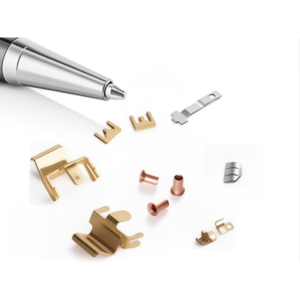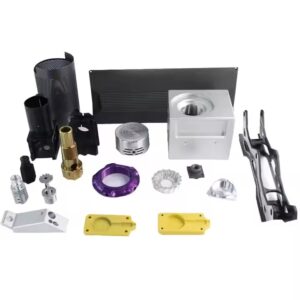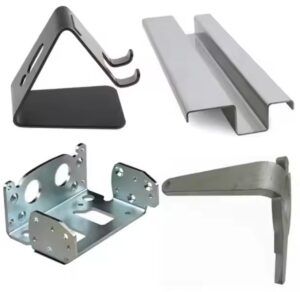Micro stamping, a pioneering technique, serves as the conduit to fabricate minute metallic components replete with intricate contours and features. The applications of micro stamping traverse diverse industries encompassing medical, aerospace, and electronics, among others. Yet, within this innovative realm, material selection assumes paramount importance, beset with challenges and requisites of the highest order. In the forthcoming discourse, we shall embark on a journey to discern the categories of materials that harmoniously align with the exigencies of micro stamping and unravel the reasons behind this congruence.
Factors Affecting Material Selection for Micro Stamping
The micro stamping paradigm orchestrates the application of elevated pressure and temperature upon slender metal sheets, thereby fashioning diminutive constituents adorned with intricate geometries and precision tolerances. This intricate endeavor prompts the intricate dance of multiple factors steering the selection of materials suitable for micro stamping:
- Material Thickness and Hardness: The gauge of the material carries profound implications, dictating the proportions and form of the micro stamped constituents. Simultaneously, the tenor of material hardness exerts influence, influencing the wear dynamics of the micro stamping instruments and the integrity of the component surfaces. Generally, thinner and more malleable substrates facilitate the micro stamping process; however, they might also exhibit heightened susceptibility to detriment or deformation.
- Material Strength and Ductility: The potency of the material embodies its resistance to fracture or cleavage under duress. Concomitantly, the material’s ductility signifies its propensity to stretch or bend devoid of fracturing. The interplay of strength and ductility assumes pivotal relevance in micro stamping endeavors, governing the material’s aptitude to endure the rigors of heightened pressure and temperature and its capacity to coalesce with the coveted dimensions and contours of the components.
- Material Conductivity and Corrosion Resistance: The material’s conductivity presages its adeptness in transmitting heat and electrical currents. Meanwhile, the resilience to corrosion delineates the material’s ability to fend off oxidation or degradation attributed to exposure to atmospheric conditions, aqueous media, or chemical agents. Both attributes, conductivity, and corrosion resistance, stand germane to the micro stamping enterprise, impacting the operational efficiency and lifespan of the micro stamped components, particularly when encountering extreme temperatures or acerbic surroundings.
- Material Availability and Cost: The accessibility quotient gauges the ease with which the material can be procured and processed. Meanwhile, the economic consideration scrutinizes the fiscal implications associated with the procurement and utilization of the chosen material. Both facets, availability, and cost, assume the role of linchpins within the micro stamping sphere, orchestrating the feasibility and profitability of the process.
Examples of Materials Suitable for Micro Stamping
In accordance with these parameters, a plethora of materials emerge as prime contenders for seamless integration into the micro stamping narrative:
- Copper and Copper Alloys: Characterized by their superlative conductivity and pliability, copper and its various alloys, such as brass and bronze, stand poised to undergo micro stamping, giving birth to slender and intricate components. These alloys further confer enhanced robustness and resistance to corrosion, positioning them as favored substrates within the realm of electronics, including connectors, switches, and sensors.
- Stainless Steel: Celebrated for its robust constitution and imperviousness to corrosion and oxidation, stainless steel lends itself to the micro stamping tableau, yielding meticulously crafted components characterized by surface finesse and precision. Its prevalence within the medical arena extends to implants, instruments, and needles, where its durability remains a prized asset.
- Nickel and Nickel Alloys: Nickel, as a hardwearing and unyielding metal, finds application in scenarios demanding resilience against heightened temperature and pressure. Its alloyed iterations, exemplified by Inconel and Monel, encapsulate mechanical and chemical attributes conducive to operation within extreme environments. Aerospace applications, such as turbines, valves, and nozzles, stand testament to the efficacy of these materials.
- Titanium and Titanium Alloys: The lightweight character and formidable tensile strength endow titanium with an enviable strength-to-weight ratio. These characteristics converge with corrosion resistance to render it an apt choice for applications demanding sturdiness and resilience. The alloys, notably Ti-6Al-4V and Ti-6Al-7Nb, extend these attributes, evoking suitability for medical and aerospace applications such as implants, prosthetics, and fasteners.
Advantages and Disadvantages of Each Material
Each material harbors a constellation of attributes bearing both advantages and limitations within the micro stamping domain, contingent upon their distinct purposes and inherent traits. The ensuing array captures these nuances:
- Copper and Copper Alloys: Distinguished by conductivity and pliancy, copper alloys seamlessly surrender to micro stamping’s intricate demands, necessitating minimal force for their transformation. Yet, their proclivity towards brittleness and diminished strength in the face of stress or heat imparts a susceptibility to deformation. In the passage of time, copper and its alloys may undergo tarnishing or oxidation if not vigilantly guarded or coated.
- Stainless Steel: The durability and strength of stainless steel empower it to defy the ravages of corrosion and wear. Nonetheless, its innate hardness and thickness pose challenges to micro stamping endeavors, impinging upon precision when sculpting intricate details. In addition, the process may elicit elevated friction and heat, potentially affecting both tool longevity and component excellence.
- Nickel and Nickel Alloys: Displaying tenacious fortitude against temperature and pressure extremes, nickel and its alloys stand unwavering. However, their elevated cost and scarcity act as stumbling blocks, constraining accessibility and affordability. Notably, in select scenarios, nickel may instigate allergic responses or toxicity, thus curtailing its deployment in particular applications.
- Titanium and Titanium Alloys: Endowed with a featherweight constitution and formidable strength, titanium emerges as a beacon of high performance. Nevertheless, its insulating properties and pronounced elasticity pose challenges when endeavoring to micro stamp intricately proportioned components with minimal exertion.
Moreover, titanium’s interaction with oxygen or nitrogen under elevated temperatures introduces the potential for alteration in its inherent characteristics or aesthetic appearance.
Conclusion
The realm of material selection is inextricably woven into the tapestry of micro stamping success, its influence cascading upon the quality, functionality, and cost implications of the micro stamped components. Thus, the judicious evaluation of parameters such as material thickness, hardness, strength, ductility, conductivity, corrosion resistance, availability, and cost emerges as a pivotal choreography dictating the course of selection.
Furthermore, a granular dissection of each material’s merits and demerits, encompassing copper and copper alloys, stainless steel, nickel and nickel alloys, and titanium and titanium alloys, is requisite to navigate the labyrinthine landscape of micro stamping materials effectively. This informed decision-making process is quintessential in steering micro stamping projects towards their zenith of success.
We ardently hope that this discourse has fostered a holistic comprehension of the materials that synergistically align with the principles of micro stamping and the rationale that underscores their aptitude. Should inquiries or insights beckon, we wholeheartedly invite you to pen your thoughts in the comment section below or engage with us directly. Your participation and readership are deeply appreciated as we traverse this realm of knowledge and innovation.




